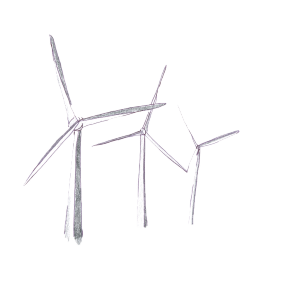
Morgan Kennedy, Staff Illustrator
In a time when the energy industry is still dominated by the fossil fuel giants, we have seen a lot of anti-renewable rhetoric spewing from the mouths of those with interests in maintaining the status quo. Unfortunately, sometimes these blatant falsities are believed and reduplicated — as we saw in the April 5 op-ed “Gone with the wind: hidden costs to ‘green’ projects,” in this publication. It is disheartening to see misinformation presented to condemn an industry dedicated to harnessing one of the least obtrusive and destructive sources of energy out there, so allow me to shed some light on the numbers and positions presented in last week’s editorial.
First, the argument on ornithological concern is extremely outdated. It dates back to the early 1980s, to Altamont Pass, one of the first wind farms in the United States. The small, now-outdated turbines constructed back then were more dangerous for birds: The blades spun much faster, and there were places in which predatory birds could perch. Since then, windmill design has improved drastically, increasing in efficiency and eliminating these safety risks. Concerns for birds and bats are now always taken into account when planning new wind sites, in accordance with relatively new guidelines set by the U.S. Fish and Wildlife Service (FWS) and Bat Conservation International.
On the issue of bird mortality, the statistics reported last week were absolutely incorrect. FWS reports that wind turbines account for 33,000 bird deaths per year, significantly lower than the 500,000 claimed last week. To put this in perspective, turbine collisions account for 0.003 percent of bird deaths caused by humans. Pets, power lines, pesticides, automobiles and communication towers, on the other hand, each contribute several million deaths per year — power lines alone are estimated to contribute 130 million deaths per year; pesticides come second at 70 million.
Next is the issue of unwanted sound produced by the turbines. Claims of sound pollution have long been voiced by opponents of wind power, and again they are largely unfounded. Turbines today are much quieter than those of the pioneering farms like Altamont Pass. They are so quiet, in fact, that from outside a house built as close as legally possible to a wind turbine, the sound would be somewhere between the volume of a refrigerator and a window air conditioner. From 500 meters away, the sound is significantly quieter than the typical background noise of a populated area. To suggest that wind energy has a negative environmental value — that the minimal impact on bird life and the hum of the turbines outweighs the positives of providing a clean energy source with no carbon emissions — is an absolutely absurd leap of logic.
To assert that wind turbines are an inefficient way to reduce emissions is an even more absurd assertion. But, define efficiency. The most efficient ways of reducing carbon emissions are through energy conservation and demand-side management. After that, one utilizes emission-free sources of energy: wind, solar and water. These methods may not be the most inexpensive ways to do things, as there are relatively high initial costs when it comes to renewable energy sources, but environmental and public health benefits outweigh this investment. Sustainable, renewable energy is seen as progress, something worth developing — and that is why we subsidize it. These subsidies are what allow renewable technologies to continue development in a market dominated by unsustainable fossil fuel sources.
The claim presented last week that wind energy receives eight times as much federal funding as fossil fuel-based energy is entirely unfounded. According to the Government Accountability Office, over a period of five years, fossil fuel-based sources received almost five times as much money ($10.9 billion more) in federal incentives than all renewable energy technologies combined. Furthermore, to assert that the market should regulate energy independent of any government aid is also preposterous; no energy sector has been developed without subsidies, including the oil, coal and natural gas industries. Endorsement and promotion of renewable resources is completely justifiable and should be encouraged.
Ultimately, wind energy on a large scale should be judged based on scientific studies, common sense and a healthy concern for future generations — not on outdated concerns and misreported statistics. To continue to present unfounded arguments from decades past — promoted in large part by big oil interests — and to dismiss the opportunity to secure a future powered by sustainable energy practices is a travesty. I, for one, believe in progress, and I will not be content with harmful, archaic fossil fuel practices.
Putnam is a member of the class of 2015.




